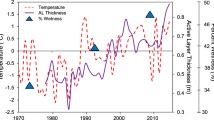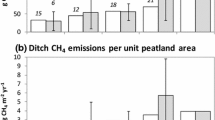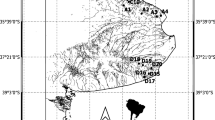Abstract
Small ponds account for a disproportionately high percentage of carbon dioxide emissions relative to their small surface area. It is therefore crucial to understand carbon flow in these ponds to refine the current global carbon budget, especially because climate change is affecting pond hydrology. High elevation ponds in the Elk Mountains of western Colorado are drying more frequently as the timing of snowmelt advances. We compared CO2 concentrations and fluxes among ponds of different hydroperiods over diel sampling periods during the course of the 2017 open-water period. CO2 concentrations were significantly negatively correlated with pond depth and averaged 77.6 ± 24.5 μmol L−1 (mean ± S.E.) across all ponds and sampling events. Ponds were up to twenty times supersaturated in CO2 with respect to the atmosphere. Flux was highly variable within individual ponds but correlated with time of sampling and was highest at night. Flux averaged 19.7 ± 18.8 mg CO2 m−2 h−1 across all ponds and sampling events. We also compared flux values obtained using modeled and empirical methods and found that widely-applied models of gas exchange rates using wind-based gas exchange (K) values yielded estimates of CO2 flux that were significantly higher than those obtained using the floating chamber approach, but estimates of CO2 flux using globally averaged convection-based K values were lower than those obtained using the floating chambers. Lastly, we integrated soil vs. water efflux measurements with long-term patterns in hydrology to predict how total season-long efflux might change under the more rapid drying regimes and longer seasons that are already occurring in these systems. Because soil CO2 efflux averaged 277.0 ± 49.0 mg CO2 m−2 h−1, temporary ponds emitted 674.1 ± 99.4 kg CO2 m−2 over the course of the 2017 season from ice-out to refreezing, which was over twice as much as permanent and semi-permanent ponds. Our results emphasize that contributions of CO2 from small ponds to the global carbon budget estimates will vary with pond hydroperiod and sampling methodology, which have been overlooked given that most previous estimates were collected from limited sampling periods and from pond waters alone. Furthermore, pond CO2 contributions are predicted to increase over time as pond areas transition from efflux from water to efflux from soil.




Similar content being viewed by others
References
Akaike H (1998) Information Theory and an Extension of the Maximum Likelihood Principle. In: Information theory and an extension of the maximum likelihood principle. Selected papers of Hirotugu Akaike. Springer, pp 199–213
Arnell NW (1999) Climate change and global water resources. Glob Environ Chang 9:S31–S49. https://doi.org/10.1016/S0959-3780(99)00017-5
Baker TT, Lockaby BG, Conner WH, Meier CE, Stanturf JA, Burke MK (2001) Leaf litter decomposition and nutrient dynamics in four southern forested floodplain communities. Soil Sci Soc Am J 65:1334–1347
Barnett TP, Adam JC, Lettenmaier DP (2005) Potential impacts of a warming climate on water availability in snow-dominated regions. Nature 438:303–309
Barton K, Barton MK (2018) Package ‘MuMIn’
Battle JM, Golladay SW (2007) How hydrology, habitat type, and litter quality affect leaf breakdown in wetlands on the gulf coastal plain of Georgia. Wetlands 27:251–260
Batzer DP, Sharitz RR (2014) Ecology of freshwater and estuarine wetlands. Univ of California Press
Batzer DP, Wissinger SA (1996) Ecology of insect communities in nontidal wetlands. Annu Rev Entomol 41:75–100
Billick I Installation, maintenance and publication of data from the RMBL weather stations has been supported by NSF award (MRI- 0821369), NSF Grant DBI #0821369, and DOE funding as well as ongoing operational support from RMBL, the upper Gunnison River water Conservancy District and the LBNL science focus area 2.0 project. Rocky Mountain Biological Station
Bonaiuti S, Blodau C, Knorr K-H (2017) Transport, anoxia and end-product accumulation control carbon dioxide and methane production and release in peat soils. Biogeochemistry 133:219–239
Boon PI (2006) Biogeochemistry and bacterial ecology of hydrologically dynamic wetlands. Ecol Freshw Estuar Wetl Univ Calif Press Berkeley 568:
Bortolotti LE, St. Louis VL, Vinebrooke RD, Wolfe AP (2016) Net ecosystem production and carbon greenhouse gas fluxes in three Prairie wetlands. Ecosystems 19:411–425. https://doi.org/10.1007/s10021-015-9942-1
Brooks RT (2009) Potential impacts of global climate change on the hydrology and ecology of ephemeral freshwater systems of the forests of the northeastern United States. Clim Chang 95:469–483. https://doi.org/10.1007/s10584-008-9531-9
Burger M, Berger S, Spangenberg I, Blodau C (2016) Summer fluxes of methane and carbon dioxide from a pond and floating mat in a continental Canadian peatland. Biogeosciences 13(12):3777–3791
Burkett V, Kusler J (2000) Climate change: potential impacts and interactions in wetlands of the Untted States1. J Am Water Resour Assoc 36:313–320. https://doi.org/10.1111/j.1752-1688.2000.tb04270.x
Carpenter SR, Fisher SG, Grimm NB, Kitchell JF (1992) Global change and freshwater ecosystems. Annu Rev Ecol Syst 23:119–139
Catalán N, von Schiller D, Marcé R et al (2014) Carbon dioxide efflux during the flooding phase of temporary ponds. Limnetica 33:349–360
Clow DW (2010) Changes in the timing of snowmelt and streamflow in Colorado: a response to recent warming. J Clim 23:2293–2306
Clymo RS, Turunen J, Tolonen K (1998) Carbon accumulation in peatland. Oikos 81:368–388
Cole JJ, Caraco NF (1998) Atmospheric exchange of carbon dioxide in a low-wind oligotrophic lake measured by the addition of SF6. Limnol Oceanogr 43:647–656. https://doi.org/10.4319/lo.1998.43.4.0647
Cole JJ, Caraco NF, Kling GW, Kratz TK (1994) Carbon dioxide supersaturation in the surface waters of lakes. Science 265:1568–1570
Cole JJ, Pace ML, Carpenter SR, Kitchell JF (2000) Persistence of net heterotrophy in lakes during nutrient addition and food web manipulations. Limnol Oceanogr 45:1718–1730
Cole JJ, Prairie YT, Caraco NF, McDowell WH, Tranvik LJ, Striegl RG, Duarte CM, Kortelainen P, Downing JA, Middelburg JJ, Melack J (2007) Plumbing the global carbon cycle: integrating inland waters into the terrestrial carbon budget. Ecosystems 10:172–185
Corcoran RM, Lovvorn JR, Heglund PJ (2009) Long-term change in limnology and invertebrates in Alaskan boreal wetlands. Hydrobiologia 620:77–89. https://doi.org/10.1007/s10750-008-9616-5
Dodson SI (1982) Chemical and biological limnology of six west-Central Colorado Mountain ponds and their susceptibility to acid rain. Am Midl Nat 107:173–179. https://doi.org/10.2307/2425198
Downing JA, Prairie YT, Cole JJ, Duarte CM, Tranvik LJ, Striegl RG, McDowell WH, Kortelainen P, Caraco NF, Melack JM, Middelburg JJ (2006) The global abundance and size distribution of lakes, ponds, and impoundments. Limnol Oceanogr 51:2388–2397
Duarte CM, Prairie YT (2005) Prevalence of heterotrophy and atmospheric CO2 emissions from aquatic ecosystems. Ecosystems 8:862–870
Elser JJ, Andersen T, Baron JS, Bergstrom AK, Jansson M, Kyle M, Nydick KR, Steger L, Hessen DO (2009) Shifts in lake N: P stoichiometry and nutrient limitation driven by atmospheric nitrogen deposition. science 326:835–837
Gilbert PJ, Cooke DA, Deary M, Taylor S, Jeffries MJ (2017) Quantifying rapid spatial and temporal variations of CO 2 fluxes from small, lowland freshwater ponds. Hydrobiologia 793:83–93
Hamilton JD, Kelly CA, Rudd JWM, Hesslein RH, Roulet NT (1994) Flux to the atmosphere of CH4 and CO2 from wetland ponds on the Hudson Bay lowlands (HBLs). J Geophys Res Atmos 99:1495–1510. https://doi.org/10.1029/93JD03020
Helton AM, Bernhardt ES, Fedders A (2014) Biogeochemical regime shifts in coastal landscapes: the contrasting effects of saltwater incursion and agricultural pollution on greenhouse gas emissions from a freshwater wetland. Biogeochemistry 120:133–147
Holgerson MA (2015) Drivers of carbon dioxide and methane supersaturation in small, temporary ponds. Biogeochemistry 124:305–318
Holgerson MA, Raymond PA (2016) Large contribution to inland water CO 2 and CH 4 emissions from very small ponds. Nat Geosci 9:222–226
Holgerson MA, Farr ER, Raymond PA (2017) Gas transfer velocities in small forested ponds. Journal of Geophysical Research: Biogeosciences 122:1011–1021
Inkley MD, Wissinger SA, Baros BL (2008) Effects of drying regime on microbial colonization and shredder preference in seasonal woodland wetlands. Freshw Biol 53:435–445
Jackson CR, Thompson JA, Kolka RK (2014) Wetland soils, hydrology and geomorphology. In: Batzer, D.; Sharitz, R., eds. Ecology of freshwater and estuarine wetlands. Berkeley, CA: University of California Press: 23-60. Chapter 2:23–60
Kelly CA, Fee E, Ramlal PS, Rudd JWM, Hesslein RH, Anema C, Schindler EU (2001) Natural variability of carbon dioxide and net epilimnetic production in the surface waters of boreal lakes of different sizes. Limnol Oceanogr 46:1054–1064
Kortelainen P, Rantakari M, Huttunen JT et al (2006) Sediment respiration and lake trophic state are important predictors of large CO2 evasion from small boreal lakes. Glob Chang Biol 12:1554–1567. https://doi.org/10.1111/j.1365-2486.2006.01167.x
Kragh T, Andersen MR, Sand-Jensen K (2017) Profound afternoon depression of ecosystem production and nighttime decline of respiration in a macrophyte-rich, shallow lake. Oecologia 185:157–170. https://doi.org/10.1007/s00442-017-3931-3
Laurion I, Vincent WF, MacIntyre S, Retamal L, Dupont C, Francus P, Pienitz R (2010) Variability in greenhouse gas emissions from permafrost thaw ponds. Limnol Oceanogr 55:115–133. https://doi.org/10.4319/lo.2010.55.1.0115
Lee S-Y, Ryan ME, Hamlet AF, Palen WJ, Lawler JJ, Halabisky M (2015) Projecting the hydrologic impacts of climate change on montane wetlands. PLoS One 10:e0136385
Lund JO, Wissinger SA, Peckarsky BL (2016) Caddisfly behavioral responses to drying cues in temporary ponds: implications for effects of climate change. Freshwater Science 35:619–630
Magnusson AK, Williams DD (2006) The roles of natural temporal and spatial variation versus biotic influences in shaping the physicochemical environment of intermittent ponds: a case study. Arch Hydrobiol 165:537–556
Natchimuthu S, Selvam BP, Bastviken D (2014) Influence of weather variables on methane and carbon dioxide flux from a shallow pond. Biogeochemistry 119:403–413
Obrador B, von Schiller D, Marcé R, Gómez-Gener L, Koschorreck M, Borrego C, Catalán N (2018) Dry habitats sustain high CO 2 emissions from temporary ponds across seasons. Sci Rep 8:3015
Pelletier L, Moore TR, Roulet NT, Garneau M, Beaulieu-Audy V (2007) Methane fluxes from three peatlands in the La Grande Riviere watershed, James Bay lowland, Canada. J Geophys Res Biogeosci 112
Pinheiro J, Bates D, DebRoy S, Sarkar D (2014) R Core team (2014) nlme: linear and nonlinear mixed effects models. R package version 3.1–117. Available H TtpCRAN R-Proj. Orgpackage Nlme
Post WM, Emanuel WR, Zinke PJ, Stangenberger AG (1982) Soil carbon pools and world life zones. Nature 298:156–159. https://doi.org/10.1038/298156a0
Power ME, Stout RJ, Cushing CE, Harper PP, Hauer FR, Matthews WJ, Moyle PB, Statzner B (1988) Biotic and abiotic controls in river and stream communities. J N Am Benthol Soc 7:456–479
R Core Team (2016) R: a language and environment for statistical computing. R Foundation for Statistical Computing, Vienna, Austria
Read JS, Hamilton DP, Desai AR, Rose KC, MacIntyre S, Lenters JD, Smyth RL, Hanson PC, Cole JJ, Staehr PA, Rusak JA, Pierson DC, Brookes JD, Laas A, Wu CH (2012) Lake-size dependency of wind shear and convection as controls on gas exchange. Geophys Res Lett 39
Read QD, Henning JA, Classen AT, Sanders NJ (2017) Aboveground resilience to species loss but belowground resistance to nitrogen addition in a montane plant community. J Plant Ecol:rtx015
Resh VH, Brown AV, Covich AP, Gurtz ME, Li HW, Minshall GW, Reice SR, Sheldon AL, Wallace JB, Wissmar RC (1988) The role of disturbance in stream ecology. J N Am Benthol Soc 7:433–455
Schuur EA, Bockheim J, Canadell JG et al (2008) Vulnerability of permafrost carbon to climate change: implications for the global carbon cycle. AIBS Bull 58:701–714
Serreze MC, Clark MP, Armstrong RL, McGinnis DA, Pulwarty RS (1999) Characteristics of the western United States snowpack from snowpack telemetry (SNO℡) data. Water Resour Res 35:2145–2160
Smol JP, Douglas MS (2007) Crossing the final ecological threshold in high Arctic ponds. Proc Natl Acad Sci 104:12395–12397
Strachan SR, Chester ET, Robson BJ (2014) Microrefuges from drying for invertebrates in a seasonal wetland. Freshw Biol 59:2528–2538
Thompson SK (2012) Sampling. John Wiley & Sons
Tuytens K, Vanschoenwinkel B, Waterkeyn A, Brendonck L (2014) Predictions of climate change infer increased environmental harshness and altered connectivity in a cluster of temporary pools. Freshw Biol 59:955–968. https://doi.org/10.1111/fwb.12319
Vachon D, Prairie YT, Cole JJ (2010) The relationship between near-surface turbulence and gas transfer velocity in freshwater systems and its implications for floating chamber measurements of gas exchange. Limnol Oceanogr 55:1723–1732
Verpoorter C, Kutser T, Seekell DA, Tranvik LJ (2014) A global inventory of lakes based on high-resolution satellite imagery. Geophys Res Lett 41:6396–6402
Wanninkhof R (1992) Relationship between wind speed and gas exchange over the ocean. J Geophys Res Oceans 97:7373–7382
Weiss R (1974) Carbon dioxide in water and seawater: the solubility of a non-ideal gas. Mar Chem 2:203–215
Wellborn GA, Skelly DK, Werner EE (1996) Mechanisms creating community structure across a freshwater habitat gradient. Annu Rev Ecol Syst 27:337–363
Williamson CE, Saros JE, Vincent WF, Smol JP (2009) Lakes and reservoirs as sentinels, integrators, and regulators of climate change. Limnol Oceanogr 54:2273–2282. https://doi.org/10.4319/lo.2009.54.6_part_2.2273
Wissinger SA, Oertli B, Rosset V (2016) Invertebrate Communities of Alpine Ponds. In: Invertebrate communities of alpine ponds. Invertebrates in freshwater wetlands. Springer, Cham, pp 55–103
Wissinger SA, Whiteman HH, Sparks GB et al (1999) Foraging trade-offs along a predator–permanence gradient in subalpine wetlands. Ecology 80:2102–2116
Acknowledgments
We thank the lab of Dr. Emily Bernhardt (Duke University) and Dr. Ashley Helton (U. Connecticut) for assistance with floating chamber design, Elin Binck for assistance with sample collection, and the Rocky Mountain Biological Laboratory and the Colorado Field Office of The Nature Conservancy for access to the Mexican Cut Nature Preserve. Work was funded by the National Science Foundation (DEB-1557015 to SAW and 1556914 to BWT) and North Carolina State University.
Author information
Authors and Affiliations
Corresponding author
Additional information
Publisher’s Note
Springer Nature remains neutral with regard to jurisdictional claims in published maps and institutional affiliations.
Electronic supplementary material
ESM 1
(DOCX 201 kb)
Rights and permissions
About this article
Cite this article
DelVecchia, A.G., Balik, J.A., Campbell, S.K. et al. Carbon Dioxide Concentrations and Efflux from Permanent, Semi-Permanent, and Temporary Subalpine Ponds. Wetlands 39, 955–969 (2019). https://doi.org/10.1007/s13157-019-01140-3
Received:
Accepted:
Published:
Issue Date:
DOI: https://doi.org/10.1007/s13157-019-01140-3




